
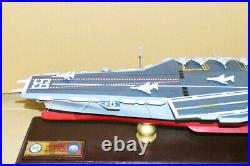
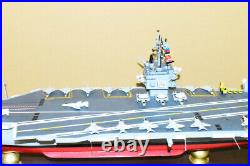

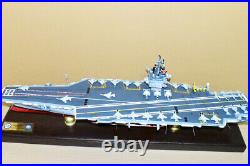
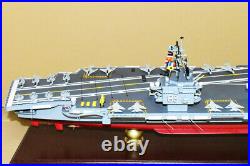

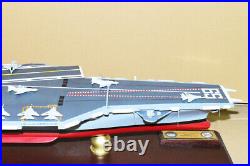
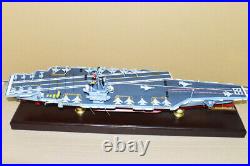
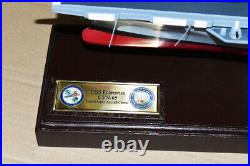

USS Enterprise (CVN-65) Aircraft Carrier Model. Sail again with the crew of the USS Enterprise (CVN-65) Aircraft Carrier in this handcrafted wooden Model. Each piece is carved from wood and handpainted to provide a piece you’ll love. Length – 36 inches. The product is not intended to be used by children 12 years and younger. USS Enterprise (CVN-65), formerly CVA(N)-65, is a decommissioned United States Navy aircraft carrier. She was the first nuclear-powered aircraft carrier and the eighth United States naval vessel to bear the name. Like her predecessor of World War II fame, she is nicknamed “Big E”. At 1,123 feet (342 m), she is the longest naval vessels ever built. Her 93,284-long-ton (94,781 t) displacement ranks her as the 12th-heaviest carrier, after the ten carriers of the Nimitz class and USS Gerald R. Enterprise had a crew of some 4,600 service members. She was inactivated on 1 December 2012, and officially decommissioned on 3 February 2017, after over 55 years of service. She was stricken from the Naval Vessel Register the same day. The name has been adopted by the future Gerald R. Ford-class aircraft carrier USS Enterprise (CVN-80). Enterprise was intended as the first of a class of six carriers, but massive increases in construction costs led to the remaining vessels being cancelled. Because of the huge cost of her construction, Enterprise was launched and commissioned without the planned RIM-2 Terrier missile launchers. Later upgrades added two NATO Sea Sparrow (NSSM) and three Mk 15 Phalanx CIWS gun mounts. One CIWS mount was later removed and two 21-cell RIM-116 Rolling Airframe Missile launchers were added. Enterprise is also the only aircraft carrier to house more than two nuclear reactors, [6] having an eight-reactor propulsion design, with each A2W reactor taking the place of one of the conventional boilers in earlier constructions. [29] She is the only carrier with four rudders, two more than other classes, and features a more cruiser-like hull. Enterprise also had a phased array radar system known as SCANFAR. SCANFAR was intended to be better at tracking multiple airborne targets than conventional rotating antenna radars. SCANFAR consisted of two radars, the AN/SPS-32 and the AN/SPS-33. The AN/SPS-32 was a long-range air search and target acquisition radar developed by Hughes for the U. The AN/SPS-32 operated together with the AN/SPS-33, which was the square array used for 3D tracking, into one system. The technology of the AN/SPS-32 was based on vacuum tubes and the system required constant repairs. The SPS-32 was a phased array radar which had a range of 400 nautical miles against large targets, and 200 nautical miles against small, fighter-size targets. These early phased arrays, replaced around 1980, were responsible for the distinctive square-looking island. While they are considered to be an early form of “phased array” radar, it would take the later technology of the Aegis phased array AN/SPY-1 with its electronically controlled beam steering to make phased array radars both reliable and practical for the USN. [citation needed] The dome above the SCANFAR contained the unique electronic warfare suite, the Andrew Alford AA-8200 dipole antennas (which never acquired a military designation). The system consisted of six rows of antennae encircling the dome. The antennae in the upper two rows were encased in piping radomes as they were small and fragile. In 1958, Enterprise’s keel was laid at Newport News Shipbuilding and Drydock Company in Shipway 11. Franke, wife of the former Secretary of the Navy. On 25 November 1961, Enterprise was commissioned, with Captain Vincent P. De Poix, formerly of Fighting Squadron 6 on her predecessor, in command. On 20 February 1962, Enterprise was a tracking and measuring station for the flight of Friendship 7, the Project Mercury space capsule in which Lieutenant Colonel John H. Made the first American orbital spaceflight. Enterprise completed shakedown activities at Naval Station Norfolk on 5 April 1961.
